 | |
| Author | Bruce Heard |
|---|---|
| Genre | Role-playing game |
| Publisher | TSR, Inc. |
Publication date | 1988 |
The Orcs of Thar is an accessory for the Dungeons & Dragons fantasy role-playing game, written by Bruce Heard and published by TSR in 1988.
 | |
| Author | Bruce Heard |
|---|---|
| Genre | Role-playing game |
| Publisher | TSR, Inc. |
Publication date | 1988 |
The Orcs of Thar is an accessory for the Dungeons & Dragons fantasy role-playing game, written by Bruce Heard and published by TSR in 1988.
The Orcs of Thar (GAZ10) was written by Bruce Heard, with cover art by Clyde Caldwell, and interior illustrations by Jim Holloway. It was published by TSR in 1988 and included two 48-page books, a large color map, cardstock counters, and an outer folder. [1] Editing was by Gary L. Thomas, and cartography by Dave Sutherland. [2] The Orcs of Thar was the tenth in TSR's series of D&D Gazetteers; each Gazetteer detailed part of D&D's Known World campaign setting, providing information on culture, society, history, geography, economics, and prominent NPCs of a given nation. [2] The "Orc Wars" board game first appeared in Dragon Issue 132, although the game's counters in The Orcs of Thar are printed on heavier stock than was used in the magazine. [2]
The Orcs of Thar is a campaign setting book that details the fictional Broken Lands that are inhabited by humanoids such as orcs, goblins, and bugbears. [1] The "Player's Guide" is written for using orcs as player characters, and includes a description of the how orcs view the world, an overview covering the Broken Lands, rules for character creation, and a section called "Thar's Manual of Good Conduct". [1] The "Players' Guide" provides the history of the various humanoid races as seen through their own eyes, and describes the situation in the Broken Lands with an account of the ten tribes, their beliefs, and the areas they inhabit. [2] It includes rules for generating humanoid player characters such as kobolds, goblins, orcs, hobgoblins, gnolls, bugbears, ogres, and trolls. [2] Tables and suggestions for generating height, physical appearance, outlook, and various skills are available to add depth to the characters. [2] "Thar's Manual of Good Conduct", a guide to portraying characters' obnoxious behavior and battle-lust, comes as part of the "Players' Guide" but is intended to be pulled out of the booklet, cut up, and stapled into a smaller booklet. [2]
The "Orcs of Thar" booklet includes information on orcish shamans, important leaders of the humanoid tribes, how to run campaigns in the Broken Lands, and an adventure scenario. [1] The gazetteer includes rules for adaptation the set to Advanced Dungeons & Dragons, and rules for a simple conquest board game for orcs. [1] The "Dungeon Master’s Booklet" gives the “real” history of the humanoids and details on the major NPCs in the Broken Lands. [2] It includes new rules for playing shamans and wiccas as character classes, as well as nonhuman spell-casters described in the D&D Master Set , clerics and magic-users of the humanoid races. [2] The "Dungeon Master’s Booklet" provides information about the best way to stage and present humanoid adventures, along with adventure outlines. [2] It presents details of the orcish city Oenkmar, allowing humanoids and humans to explore, and lists the rules for tlachtli, a ball game played in Oenkmar. [2]
The board game included is called Orc Wars, and is set in and around the Broken Lands and features a power struggle to become the top humanoid. [2]
Jim Bambra reviewed The Orcs of Thar for Dragon magazine #148 (August 1989). Bambra wrote that the original 1974 version of D&D gave "very skimpy" guidelines on using monsters as player characters, and that subsequent editions became more human and demihuman oriented. With The Orcs of Thar, "the D&D game returns to its roots by allowing players to take on the roles of monsters: dirty, smelly, depraved humanoids, the kind of scum that players love to hate. [...] Now, The Orcs of Thar gives the opportunity to play the bad guys in a detailed and humorous campaign." [2] He considered the material "fun to read and informative", which "does an excellent job of describing the lifestyles of orcs and other humanoids". [2] He enjoyed Jim Holloway's "fun-filled art", which does "an excellent job of capturing the flavor of humanoid life". [2] Bambra stated that the character generation system handles the different types of humanoid creatures in a smooth and integrated manner: "Being big has its advantages, since you start with more Hit Dice than the other creatures, but it takes you far longer to gain additional Hit Dice than it does for the lowly kobolds, goblins, or orcs." [2] He wrote that the adventure outlines "do a superb job of capturing the flavor and atmosphere of humanoid adventuring, with plenty of opportunities for groveling and attacking the hated humans". [2] He also called the "Orc Wars" board game "good fun". [2] Bambra concluded the review by saying, "The Orcs of Thar combines neat monster descriptions and backgrounds with a colorful and humorous narrative style of presentation. Couple this with its high-quality graphic presentation, and you end up with a product that no one should be without. The Orcs of Thar is wonderfully conceived and executed. Even if the idea of having humanoid characters doesn’t appeal to you, the background material in The Orcs of Thar still makes it a valuable contribution to your campaign." [2]
According to Lawrence Schick in his 1991 book Heroic Worlds, The Orcs of Thar is "written in a humorous style that presents orcs as lovable goofballs who just happen to enjoy slaughter and pillage". [1]

Dungeonland (EX1) is a 1983 adventure module for the Dungeons & Dragons (D&D) roleplaying game, written by Gary Gygax for use with the First Edition Advanced Dungeons & Dragons (AD&D) rules. It is an adaptation of Lewis Carroll's 1865 novel Alice's Adventures in Wonderland, with the various characters from the book translated into AD&D terms.
Al-Qadim is a campaign setting for the Dungeons & Dragons role-playing game which was developed by Jeff Grubb with Andria Hayday for TSR, Inc., and was first released in 1992. Al-Qadim uses One Thousand and One Nights as a theme and is set in the land of Zakhara, called the Land of Fate. Thematically, the land of Zakhara is a blend of the historical Muslim Caliphates, the stories of legend, and a wealth of Hollywood cinematic history. Zakhara is a peninsula on the continent of Faerûn in the world of Toril, the locale of the Forgotten Realms campaign setting, although Al-Qadim is designed to stand on its own or be added to any existing campaign setting. The basic campaign setting was divided between two game products: Al-Qadim: Arabian Adventures, a sourcebook describing character creation rules, equipment, and spells unique to the setting, and Al-Qadim: Land of Fate, a boxed set describing the land of Zakhara, with separate sourcebooks for the players and the Dungeon Master.
The Dungeons & Dragons Basic Game is an introductory version of Dungeons & Dragons (D&D) role-playing game packaged in the form of a board game. The original game was released in 2004 by Wizards of the Coast and was designed by Jonathan Tweet, one of the D&D 3rd edition designers. A new version of this game was released in September 2006.

The Forgotten Temple of Tharizdun is an adventure module for the Dungeons & Dragons (D&D) role-playing game, for use in the World of Greyhawk campaign setting. The module was published by TSR, Inc. in 1982 for the first edition Advanced Dungeons & Dragons rules.

In the Dungeons & Dragons role-playing game, orcs are a primitive race of savage, bestial, barbaric humanoid.

Kobolds are a fictional race of humanoid creatures, featured in the Dungeons & Dragons roleplaying game and other fantasy media. They are generally depicted as small reptilian humanoids with long tails, distantly related to dragons.

In the Dungeons & Dragons fantasy role-playing game, goblins are a common and fairly weak race of evil humanoid monsters. Goblins are non-human monsters that low-level player characters often face in combat.
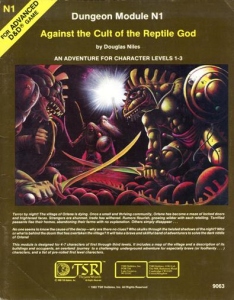
Against the Cult of the Reptile God is an adventure module for the first edition of the Advanced Dungeons & Dragons fantasy roleplaying game, set in the game's World of Greyhawk campaign setting. It is designed for novice players and gamemasters. The suggested party size is 4-7 characters of level 1-3.
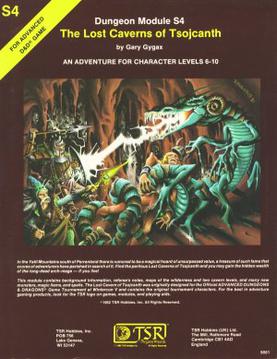
The Lost Caverns of Tsojcanth is an adventure module for the Dungeons & Dragons fantasy role-playing game. It was written by Gary Gygax and published by TSR in 1982 for the first edition Advanced Dungeons & Dragons (AD&D) rules. The 64-page adventure bears the code "S4" and is set in the Greyhawk campaign setting. It is divided into two parts, a 32-page adventure, and a 32-page booklet of monsters and magic items. The plot involves the player characters investigating rumors of lost treasure. After traversing a wilderness and two levels of dungeons, the players face Drelnza, the vampiric daughter of long-deceased archmage Iggwilv.
Tritons are a fictional species in the Dungeons & Dragons fantasy role-playing game.

The Complete Book of Humanoids is a sourcebook for the second edition of the Advanced Dungeons & Dragons fantasy adventure role-playing game.
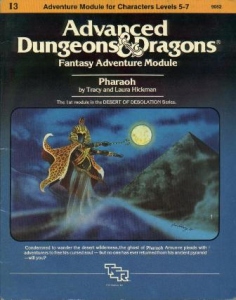
Desert of Desolation is a compilation adventure module published by TSR for the Dungeons & Dragons (D&D) fantasy roleplaying game. It combines three previously published individual modules: Pharaoh, Oasis of the White Palm, and Lost Tomb of Martek. The modules were made for use with the first edition Advanced Dungeons & Dragons (AD&D) rules. Pharaoh was created by Tracy and Laura Hickman soon after the couple married in 1977, and published by TSR in 1982. Oasis of the White Palm was a collaboration between Tracy Hickman and Philip Meyers, and Hickman wrote the Lost Tomb of Martek on his own; both were printed in 1983.

Horror on the Hill is an adventure module published by TSR, Inc. in 1983, for the Basic Rules of the Dungeons & Dragons fantasy role-playing game. Its product designation was TSR 9078. This 32-page book was designed by Douglas Niles, and features cover artwork by Jim Roslof. It is intended for beginning gamemasters and 5–10 player characters of levels 1–3. The module contains around 20 encounters on the surface, a monastery, three dungeon levels and three new monsters.

Night's Dark Terror is an adventure module for the Dungeons & Dragons (D&D) fantasy role-playing game written by British game designers Jim Bambra, Graeme Morris, and Phil Gallagher. It was designed specifically for campaigns transitioning from the D&D Basic Set to the D&D Expert Set. The player characters (PCs) journey from a farmstead into uncharted wilderness, where they encounter new hazards and contend with a secret society. The adventure received a positive review from White Dwarf magazine.
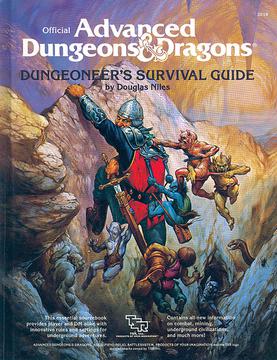
Dungeoneer's Survival Guide is a supplement to the Dungeons & Dragons fantasy role-playing game. The book was written by Douglas Niles, and published by TSR, Inc. in 1986.

Dwellers of the Forbidden City is an adventure module, or pre-packaged adventure booklet, ready for use by Dungeon Masters in the Dungeons & Dragons (D&D) fantasy role-playing game. The adventure was first used as a module for tournament play at the 1980 Origins Game Fair, and was later published by TSR in 1981 for use with the first edition Advanced Dungeons & Dragons rules. The module was written by game designer David "Zeb" Cook, who partly ascribes his hiring by TSR to his work on this module. In the adventure, the characters are hired to find an object taken to a lost oriental-style city, which has been taken over by a cult of snake-worshipers, the yuan-ti, and their servants, the mongrelmen and tasloi.
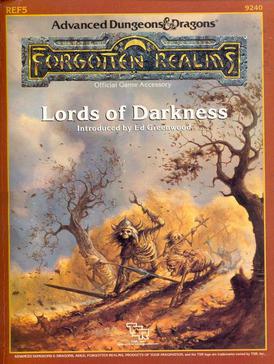
Lords of Darkness is the name of two accessories for the fictional Forgotten Realms campaign setting for the Dungeons & Dragons fantasy role-playing game.

Bestiary of Dragons and Giants is an accessory for the Dungeons & Dragons fantasy role-playing game, published in 1987 by TSR.
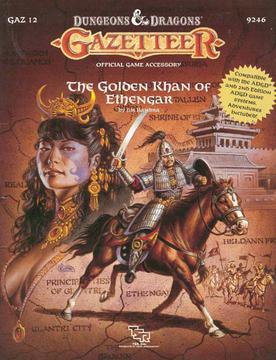
The Golden Khan of Ethengar is an accessory for the Dungeons & Dragons fantasy role-playing game.
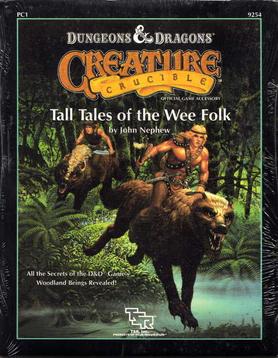
Tall Tales of the Wee Folk is an accessory for the Dungeons & Dragons fantasy role-playing game.